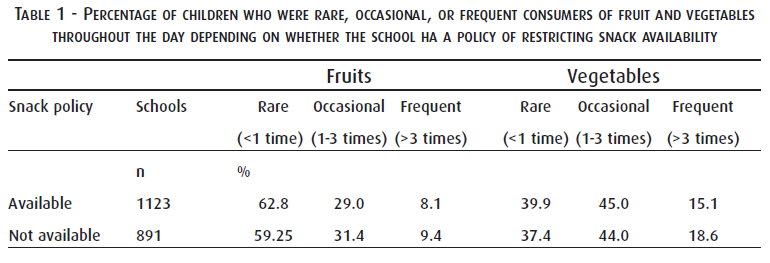Restricting snacks in US elementary schools is associated with higher frequency of fruit and vegetable consumption
US children have a diet that is poor in quality, rich in sugar and fats, and low in fruits, vegetables, and whole grains. In its report, the Institute of Medicine proposed to decrease availability of snacks in schools, without decreasing availability of fruits and vegetables (F&V)1.
The objective of the authors was to examine whether a policy that restricts the availability of snack foods in the schools is associated with greater F&V consumption in a nationally representative sample of 5th grade children2.
Early Childhood Longitudinal Study-Kindergarten cohort
The Early Childhood Longitudinal Study-Kindergarten cohort includes 10,285 5th grade children from 2065 elementary schools3.
Children were asked how many times during the last week they ate green salad, carrots, potatoes (except French fries, fried potatoes or chips), other vegetables and fruits (except fruit juices). Responses were coded as rarely (<1 time/day), occasionally (1-3 times/day) or frequently (>3 times/ day). Schools administrators were asked about availability of different snacks in their school in vending machine and canteen, cafeteria, and snack bar. This included snacks rich in sugar and fats (e.g., chocolate bars, candies, cookies, crackers, cakes, ice cream, salty snacks) and also low-fat snacks and bread products (e.g., bread sticks, rolls, bagels). School policy was defined as “restricted” when no snack was available and “unrestricted” when at least one snack was available.

Availability of snacks and fruits and vegetables consumption
• Children did not consume the recommended daily intake of F&V (table 1).
• 40% of the children consumed fruits rarely (less than 1 time/day) and 61% consumed vegetables less than 1 time/day.
• 9% of the children consumed fruits frequently (more than 3 times/day) and 16% consumed vegetables more than 3 times/day.
• Children reported higher frequency of consumption of F&V when their schools had a restricted snack policy.
• When schools had an unrestricted snack policy, the number or types of snacks available did not play a significant role in defining the association between snack availability and F&V consumption.
Other factors influence fruits and vegetables consumption
The authors observed modest differences in consumption of f&v between children in schools with restricted policy and children in schools with an unrestricted policy. These modest results are not so surprising when we consider all the other environmental factors that can influence F&V consumption4, 5 such as availability at home, accessibility, household characteristics, parental intake, and education. Nevertheless a restricted school policy for snacks could play an important role in improving children’s diet quality because they spend a lot of time at school and it can help them to make healthier choices.
References
- Committee on Nutrition Standards for Foods in Schools. Nutrition standards for foods in school: leading the way toward heathier youth. Washington, DC: Institute of Medicine; 2007.
- Gonzalez w. et al. J. Nutr. 2009; 139:142-144,
- US Department of Education. Early Childhood Longitudinal Study-Kindergarten-fifth grade public-use data file ECLS-K. Washington, DC: US Department of Education; 2004.
- Cullen KW et al. Health Educ Behav. 2003; 30:615-26.
- Van der Horst K et al. Health Educ Res. 2007; 22:203-26.
